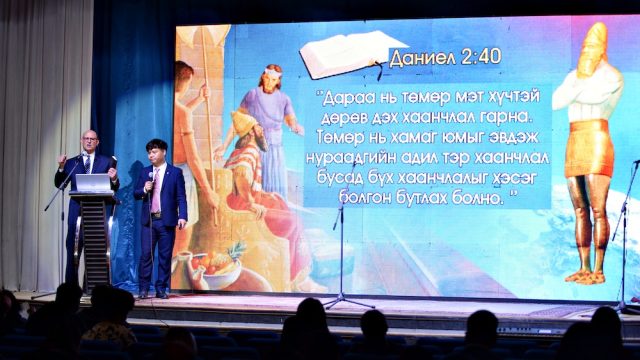Christ makes us all conquerors.

Our home in Alabama sits near a nature reserve. Because of some endangered animal or plant species, the United States government believes that preserving the habitat will assist the ecosystem of the area.
I decided one Sunday morning to plant a watermelon and cantaloupe garden, two summer fruits. That way my then 2-year-old granddaughter, Genesis, could pick fruit with Granddad and have lasting memories.
Because I was catching a plane that afternoon for Annual Council at the General Conference, my wife suggested: “Take some garment boxes and put them on top of the weeds. Then when you come back, the weeds will have died, and they will be easier to remove.” So I grabbed four large wardrobe boxes, flattened them, and laid them over the grass.
A week later I thought, Let’s see how the weeds did without sun, rain, or breeze. Lifting the first box, I saw a snake, about two and a half feet long. I thought, It’s a king snake, a nonvenomous member of the local rodent patrol.
Then my instincts told me, “Better check.” So I picked up a board about four inches wide, a half-inch thick, and four feet long. I positioned myself a safe distance from the snake and reached out with the board, and the snake coiled into a striking position and struck the board. I did it again, and it struck again. As it struck the third time I noticed its snow-white mouth. I recognized it as a cottonmouth from the preserve.
I wanted to run away, but I couldn’t leave the snake there. I imagined my granddaughter, Genesis, playing barefoot in the backyard. I thought of this poisonous animal striking my innocent granddaughter.
I took one of those four-foot-long boards in my hand, measured it over the serpent’s head, lifted it as if it were a sledgehammer, and with one swing struck the snake on its head.
The Original Intruder
In a garden called Eden a serpent took up residence. He did not come as a threat, but presented himself as a friend. But he struck nonetheless. The strike of the old serpent, called the devil and Satan (Rev. 12:7), landed in the hearts and minds of our first parents, infecting the universe with the venom of sin.
Sin kills. It kills families. It kills marriages. It kills relationships. It kills peace.
But we, the human family, did not believe that sin kills. For 4,000 years we tried to save ourselves from the power of sin. We offered human sacrifices. We prayed, shed tears, built monuments, erected altars. We gave 4,000 years of our best effort—all to no avail.
“But when the fullness of time had come, God sent forth His Son” to redeem us (Gal. 4:4). In His blood is the antivenom, released on a cross. He carried a cross—His cross and ours—and sacrificed His blood. At the cross our victorious Christ smashed the head of the serpent.
The devil is defeated; the power of evil has been broken; the title deed to Planet Earth is reclaimed. If our Adventist eschatology fails to announce this victory, it fails the test of Scripture. For eschatology is not so much about matching daily headlines with Bible texts or placing current events alongside the slide rule of history, though each of these certainly has its appropriate place.
Eschatology, the study of last-day events, is not about frightening audiences with the roars of apocalyptic creatures, or birthing wild speculation about papal conspiracies, or attacking other denominations. Adventist eschatology spells victory—His victory, not ours! Jesus and His victory stand at the center of our eschatological message. “Now salvation, and strength, and the kingdom of our God, and the power of His Christ have come, for the accuser of our brethren . . . has been cast down” (Rev. 12:10). We announce the victory of Christ and the defeat of our enemy.
Wherever Satan appears in the Apocalypse, he appears as a loser. In Revelation 12:7, 8 he launches war in heaven, but he loses.
In Revelation 12:14 he persecutes the woman clothed with the sun. “But the earth helped the woman” (verse 16). Satan loses.
In Revelation 12:13 he attacks the male child of the woman, who is caught up to heaven. Satan loses.
In Revelation 12:17 he launches a three-pronged war on the remnant with two allies—the beast and the false prophet (Rev. 13). Against so mighty a triumvirate the saints face an overwhelming force. But the next time we see the remnant in Revelation 14:1-3 they stand in victory on Mount Zion. Satan loses.
Do the saints stand because they are perfect? No, they stand as victorious beneficiaries of the Lamb’s victory! “They overcame him by the blood of the Lamb and by the word of their testimony” (Rev. 12:11). The Lamb wins and the adversary loses. Where Satan appears to triumph (Rev. 11:7 and 13:7), it is a temporary setback for the two witnesses and the saints; just as Satan’s apparent win at the cross collapsed beneath the power of the crucified Lamb’s resurrection.
Adventist eschatology spells victory!
God Is in Charge
Adventist eschatology must declare in the words of the famous hymn:
“This is my Father’s world,
O let me ne’er forget
That though the wrong seems oft so strong,
God is the Ruler yet.”*
See the snapshots of victory in the Lamb, standing as though it had been slain (Rev. 5). After the horrific events of Calvary, after the despair of the exiled prophet who collapsed into a fountain of tears under the booming interrogation “Who is worthy?” no one was found worthy! Crushing despair fell upon John, because if no one is worthy our salvation is a lost cause.
Then comes one of the elders: “Stop weeping, John. Someone is worthy.”
Jesus is worthy because He stood where Adam stumbled. He is worthy because He flew from where Adam fell. He is worthy because He marched through Adam’s missteps. Let the Advent message proclaim: “Christ is worthy.”
Take a look at another vision of victory in Revelation 19. “Now I saw heaven opened, and behold, a white horse. And He who sat on him was called Faithful and True, and in righteousness He judges and makes war. . . . He was clothed with a robe dipped in blood, and His name is called The Word of God. And the armies in heaven, clothed in fine linen, white and clean, followed him on white horses. . . . He treads the winepress of the fierceness and wrath of Almighty God. And he has on his robe and on his thigh a name written: KING OF KINGS, AND LORD OF LORDS” (Rev. 19:11-16).
Christ gallops out of heaven riding a white horse, wearing a garment dipped in blood. But this victory image is made more powerful by recognizing that it is related to this prophecy: “Who is this who comes from Edom, with dyed garments . . . ?” asks the prophet Isaiah (Isa. 63:1). And: “Why is your apparel red . . . ?” (verse 2).
The answer comes: “I have trodden the winepress alone” (verse 3). Gethsemane and Calvary represent the bloodletting required to purchase a fallen world.
In Revelation 19 Jesus is no longer the bruised and bloodied Lamb of Calvary. He comes as the Lion of the tribe of Judah.
The picture of Isaiah’s crimson soldier is saved for Revelation 19:11: Our story is not only a story of blood, but the promise of victory. “Now I saw heaven opened, and behold, a white horse”—a symbol of victory.
The equestrian imagery of Revelation is quite compelling. The first horse of Revelation is a white horse galloping with the gospel (Rev. 6:2). The last horse (Rev. 19) is also white. The gospel that began in victory will end in victory. It began in glory and it will end in glory. The theme of Revelation is victory, His victory, over all the forces arrayed to defeat Him.
I like this part: “He who sat on him was called Faithful” (Rev. 19:11). On our best days we falter. But He is faithful by name and character. We are faithful on occasion. But the good news of the gospel is that Christ’s faithfulness is our ticket to glory.
Satan accuses: “They are not worthy.”
God says, “Charge it to My Son’s account.”
A Garment Dipped in Blood
John continues by picking up Isaiah’s vision of a crimson soldier. John sees the crimson-red garments of the one who comes from Edom, but this time the bloody smatterings of victory are all over him: “He was clothed with a robe dipped in blood” (verse 13). He’s not the victim; He’s victorious.
We spend much time preaching about Christ’s white robe of righteousness, but I rejoice over the significance of His red robe of victory. He comes in this final vision to establish justice. The world is unjust; it slays those who are innocent. It profiles the “other.” It excludes those who are worthy and elects those who are debased. Economic exploitation, sexual trafficking, gender oppression, religious persecution, class exclusion; world systems are unjust.
The Rider on the white horse reminds us that every corrupt enemy power will be destroyed. But a remnant will be saved and justice will be established forever.
I conclude with the following observation about the red robe of victory.
- In Revelation 19 intertextuality and allusion comes into play. The only other garment in Scripture dipped in blood was Joseph’s coat in Genesis 37, which was dipped in blood to perpetrate a deception on an old father. By contrast, Jesus’ robe dipped in blood points to the transparency of His victory. Jesus fought in total transparency. No guile was found in Him, His victory has integrity, He is faithful and true. That blood-red robe says, “Trust Me.”
- That blood-red robe points to the singularity of His victory. We see a ruby-red warrior atop a snow-white steed escorted by an army of glistening glory clad in “linen, clean and white.” A billowing wave of white glory led by heaven’s Crimson Commander draped in a blood-red robe, but his army is dressed in linen clean and white (verse 14), not a drop of battle blood on them. Why is the heavenly cavalry dressed in “linen, clean and white”? Nobody wears white into battle. That’s because it is His victory, nobody else’s. It’s His battle, not ours. The battle is the Lord’s.
His robe is blood red and their robes are bleached white for one reason and one reason only: the battle is the Lord’s! God is big enough and strong enough to protect and guide His church.
Stop visiting websites, pointing fingers, and making anonymous accusations as if no one is Adventist enough except you. Is the straight testimony a laundry list of do’s and don’ts? Or is Revelation the straight testimony of the True Witness to “buy from Me gold refined in the fire” (Rev. 3:18)? Rather than point fingers at each other, why not turn our eyes upon Jesus and look full in His wonderful face?
- That robe dipped in blood points to the totality of His victory. His blood-red robe is monogrammed “King of kings, Lord of lords.”
He wears “many crowns,” so that red robe of victory signifies His right to universal rulership. One day “every knee shall bow to me, and every tongue shall confess to God” (Rom. 14:11). That blood-red robe says Praise Him!
Let us go into our fields to invite our students, our institutions, our churches, and our communities to praise Him. Because for every Seventh-day Adventist, eschatology spells victory!
* Maltbie D. Babcock, “This Is My Father’s World,” The Seventh-day Adventist Hymnal, no. 92.







